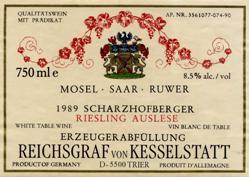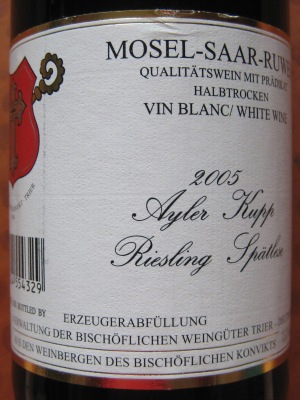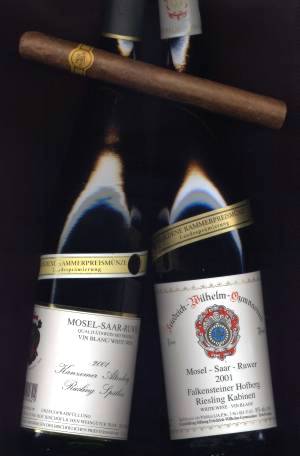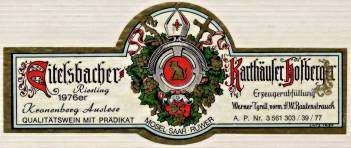The valleys of these two tributaries of the renowned Mosel are home to a few of Germany's finest vineyards. And the white wines their soils yield rank amongst the most inimitable and flavorful in the world. Journey with me as I explore the roots, vines and wines of the Saar and Ruwer.
Introduction
The valleys of Germany's Saar and Ruwer rivers may seem out of the way, both geographically and in terms of general renown, but many of the wines they produce are truly out of this world.
At their best, these wines are as enlivening as the cool, crystal clear waters of a mountain brook, as deceptively delicate and as perplexingly complex as a spider's web, and as crisply fruity as that first bite into a freshly picked apple. They also count amongst the least alcoholic of the world's wines.
But what of the people and places responsible for these lustrous liquids? Bearing many similarities, yet manifesting key distinctions, the winemakers and wine sites of the Saar and Ruwer are certainly worthy of a closer look.
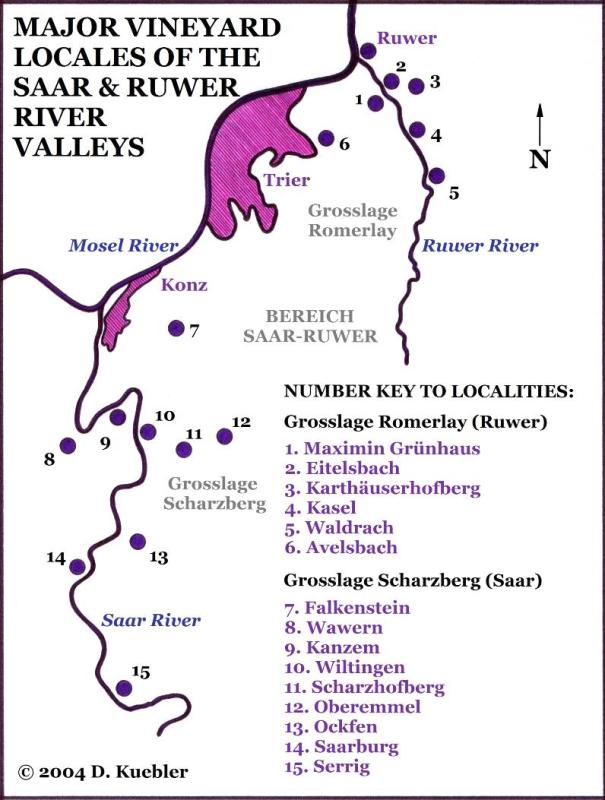
The Saar
Commencing its long course in the Vosges mountains of France, the Saar proceeds to flow northward through one of Germany's most industry-dense areas. Nonetheless, all about the river's meandering stretch just before its meeting the Mosel near the town of Konz, these surrounding sights transform from the brutal architecture of blast furnaces to the beckoning calm of farmland and vineyards.
This last looping portion of the river valley is full of paradoxes - of cool, late springs and sudden frosts, of meadowlands, forests and fruit trees, of hard, compacted slate soils and the lush foliage of grapevines.
The land's quiet beauty obscures an annual struggle of the grapes to attain sweetness and of the dedicated vintners to succeed in making great wines. We are talking, after all, of a marginal climate and of a region lying roughly at the same northerly latitude as Canada's Newfoundland.
Despite these daunting difficulties, local winegrowers do have several aces in the hole. Foremost amongst these is the Riesling vine, with roots hardy enough to tolerate cold German winters and grapes ideally suited to a gradual ripening cycle.
The town of Ayl lies just to the west of the Saar River, roughly halfway between Wawern and Saarburg.
Its south-facing Kupp vineyard can produce sensational Rieslings in great years.
Then there are the vineyards, the best of which face from southeast through due south to southwest, in order to capture as much of the day's sunshine as possible. They often rise directly over the continuously switchbacking Saar itself, or else above adjacent valleys formed by tiny bachs, or streams, that feed into the Saar, such as Falkensteiner Hofberg's Konzer Bach, Ockfener Bockstein's Ockfener Bach and Serriger Vogelsang's Serriger Bach.
The final factor in the formula is the soil, much of it slate. Not only does the slate force the roots of the vines to dig deeper in search of nutrients. It also imbues the acids in the juices of the grapes with an intensely stony, steely, mineral-laden quality. For no matter how intensely rich and sweetly honeyed the resulting wines may taste, the piercingly refreshing contribution of those slate-tinged acids still manages to permeate the flavor.
Quality vineyard sites and producers abound, making it quite difficult for me to single out any for particular praise. Nevertheless, I've enjoyed numerous fine bottles from Dr. Fischer in Wawern, Bert Simon in Serrig and von Hovel in Oberemmel. The Bischofliche Weinguter, Vereinigte Hospitien and Reichsgraf von Kesselstatt have also provided me many a pleasurable moment. All of the individual vineyard sites (einzellagen) of the Saar valley are grouped under the collective vineyard site (grosslage) name of Scharzberg.
Falkenstein and Kanzem are two tiny villages
in the Saar valley capable of producing delicious
wines in years such as 2001.
While all of the hamlets along the Saar can make memorable wines in good vintages, one vineyard locale rises above the others in terms of the ability of its Riesling vines to produce wines exhibiting that last iota of magic. The Scharzhofberg, a 67 acre knob of hill lying between the villages of Wiltingen and Oberemmel, is renowned around the world for the fragrance, depth, complexity, elegance and length of flavor of its wines.
A Riesling Auslese from the Scharzhofberger vineyard
Von Hovel and von Kesselstatt both own important holdings within the Scharzhofberg. Yet a single man by the name of Egon Muller, working from his large Victorian estate mansion at the foot of the great slope, has almost singlehandedly forged the reputation of the site. In the accomplishment of this feat, Muller carries on a family tradition spanning more than two centuries.
A trio of delights from the Saar and Ruwer vineyards

The Ruwer
The tiny Ruwer river trickles northwest from the Hunsruck toward its confluence with the Mosel, just a few miles outside of the ancient town of Trier.
Trier and its surrounding landscape, where wooded hillsides and walnut groves intermingle to create a picturesque panorama, are no strangers to wine grapes, and as far back as the 4th Century A.D., the Roman Ausonius portrayed "hillsides green with vines" in his prose. In fact, Trier was, at that time, a bustling wine center as well one of the world's four largest cities.
Owing to the rather direct course of its namesake river, most of the Ruwer's vineyards are oriented as much as is possible toward the south, occupying slopes off to either side of the main valley. The hillside of Avelsbach is an exception, lying as it does in a clearing further to the west. As with the Saar, all of the individual vineyard sites of the Ruwer are grouped under a collective vineyard site name - in this case Romerlay.
Two for the trout... A crisp Ruwer Riesling
makes for an ideal match with grilled fish.
Here, the Riesling vine reigns supreme. And it has been so for a very long time, too. For records dating back to the mid-16th Century speak of the planting of Riesling. Local inhabitants have also long realized just how integral the Riesling vine is to the land and to their lives, to the extent that the Elector of Trier, way back in 1787, ordered that all inferior vine varieties be ripped from the soil and Riesling planted in their place.
The finest Riesling wines of the Ruwer carry the stylistic theme of deceptive delicacy and underlying persistence exemplified by those of the Saar to its apotheosis, one German poet and passionate imbiber having characterized them as "the fire of the sun, the gold of the stars and the cool moonlight." At Avelsbach, the Staatlichen Weinbaudomänen produces wines which display a typically paradoxical pairing of the bracing acidity of this cool corner of the country and pear-apple fruitiness. Once again, Bert Simon, the Bischofliche Weinguter and Reichsgraf von Kesselstatt have important vineyard holdings in the region, particularly around the towns of Eitelsbach and Kasel.
One of the world's longest wine names on
one of the world's smallest wine labels
The region's two most famous wine estates, Maximin Grunhaus on the western side of the river and Karthauserhofberg on the eastern side, have long and distinguished lineages, having both once been monasteries. Maximin Grunhaus was, for instance, bequeathed to the Benedictine Monastery of Saint Maximin by Emperor Otto I, successor to Charles the Great, during the 1st Millennium A.D. Both properties produce exceptionally refined wines with noticeably restrained sweetness.
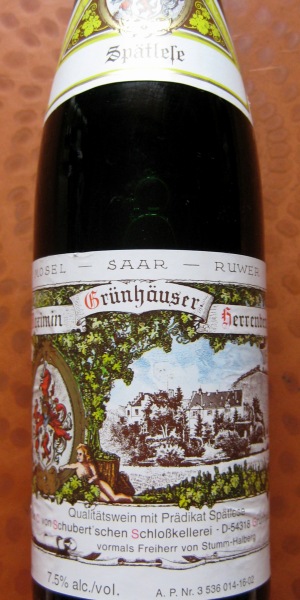
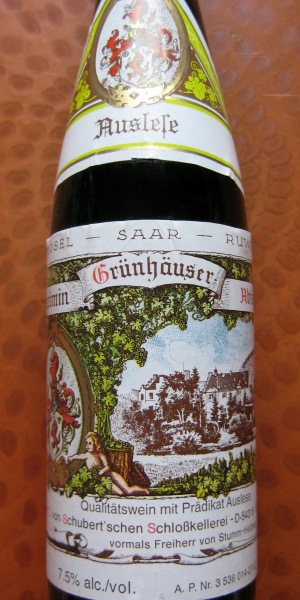
Lightness and intensity in late-harvest and select-harvest
Ruwer Rieslings from the C. von Schubert estate
Today, Maximin Grunhaus flourishes in the capable hands of Dr. Carl von Schubert and his longtime winemaker, Alfons Heinrich. From the estate's large old house, a portion of which dates back to the Roman era, von Schubert and Heinrich practice organic methods in the vineyard and favor a traditional, non-interventional approach in the cellar. This care leads to wines that often reveal a subtle interweaving of spiced fruits, herbs and floral nuances underpinned by a penetrating but not excessive mineral and citrus-laced crispness. Even though enticing in their youth and rarely registering more than 10% alcohol by volume, these wines age superbly.
Unknown Gems
Like most fine German wines, those of the Saar and Ruwer valleys continue to suffer from a widespread lack of public interest and understanding. Admittedly, the complicated German system of vineyard nomenclature and grading of ripeness makes for a more difficult selection process in the eyes of many consumers. Yet this difficulty is, in the final analysis, only skin deep. And behind an oftentimes confusing label, there lies the promise of both discovery and pleasure.
These are the wines (especially Kabinett or regular harvest and Spatlesen or late harvest) I happily pour alongside Chinese or Asian cuisine, as well as with freshly grilled trout or salmon, though they are so intrinsically tasty and well balanced that I would not hesitate to enjoy them all by themselves.
The sweeter, lusher varieties (Auslesen as in select-bunch harvested, Beerenauslesen as in individually picked overripe grapes, Trockenbeerenauslesen as in very concentrated owing to nobly rotted grapes, and Eiswein as in grapes picked and crushed while still in a frozen state), of course, call for sipping on their own or as accompaniments to desserts.
Blazing Brilliance...
Eiswein's combination of incredible sweetness
and searing acidity makes for a memorable taste treat.
I do not hesitate to say that the finest Rieslings from the Saar and Ruwer valleys are my very favorite white wines in the entire world.
Books and articles consulted in the preparation of "A Tale of Two Rivers - The Saar and the Ruwer":
"German Wine Atlas and Vineyard Register", Introduction by Edmund Penning-Rowsell, English Edition translated by Nadia Fowler, Mitchell Beazley, London, England, 1980
"Maximin Grunhaus Winery" from Gourmet Food Plaza, www.gourmetfoodplaza.com (/Series/Wineries/MaximinGrunhaus.htm), 2001
"Perfect Mosel Rieslings", Decanter Magazine, Vol.17 No.1, September 1991, Decanter Magazine Ltd., London, England
Fonte, Ron. "The Unsung Greatness of German Wines", from Ron Fonte's Consumer Wine Review, Friends of Wine Magazine, Vol.XXI No.4, Autumn 1984, Les Amis du Vin Inc., Holmes, PA, U.S.A.
Jamieson, Ian. "The Simon and Schuster Pocket Guide to German Wines", Simon and Schuster, New York, 1984
Johnson, Hugh. "The World Atlas of Wine", Simon and Schuster, New York, 1977
Pigott, Stuart. "Riesling Renaissance", Decanter Magazine, Vol.13 No.2, October 1987, Decanter Magazine Ltd., London, England
Sichel, Peter M.F. "Frank Schoonmaker's Classic The Wines of Germany", Completely Revised Edition, Hastings House, New York, 1982
Simon, André. "André Simon's Wines of the World", 2nd Edition by Serena Sutcliffe, McGraw-Hill Book Co., New York, 1981
Theise, Terry. "German Wines: Tradition of Elegance", Friends of Wine Magazine, Vol.XXI No.4, Autumn 1984, Les Amis du Vin Inc., Holmes, PA, U.S.A.
Doug Kuebler (Jazznut) is an inveterate aficionado and collector of wines and whiskies from around the world. Doug has organized wine and food seminars, and written extensively on wines and liquors. His latest book set, The Tumbler's Guide to Single Malt Scotch Whisky: Desk Reference and Field Guide, is available from Topeda Hill Publishing.
